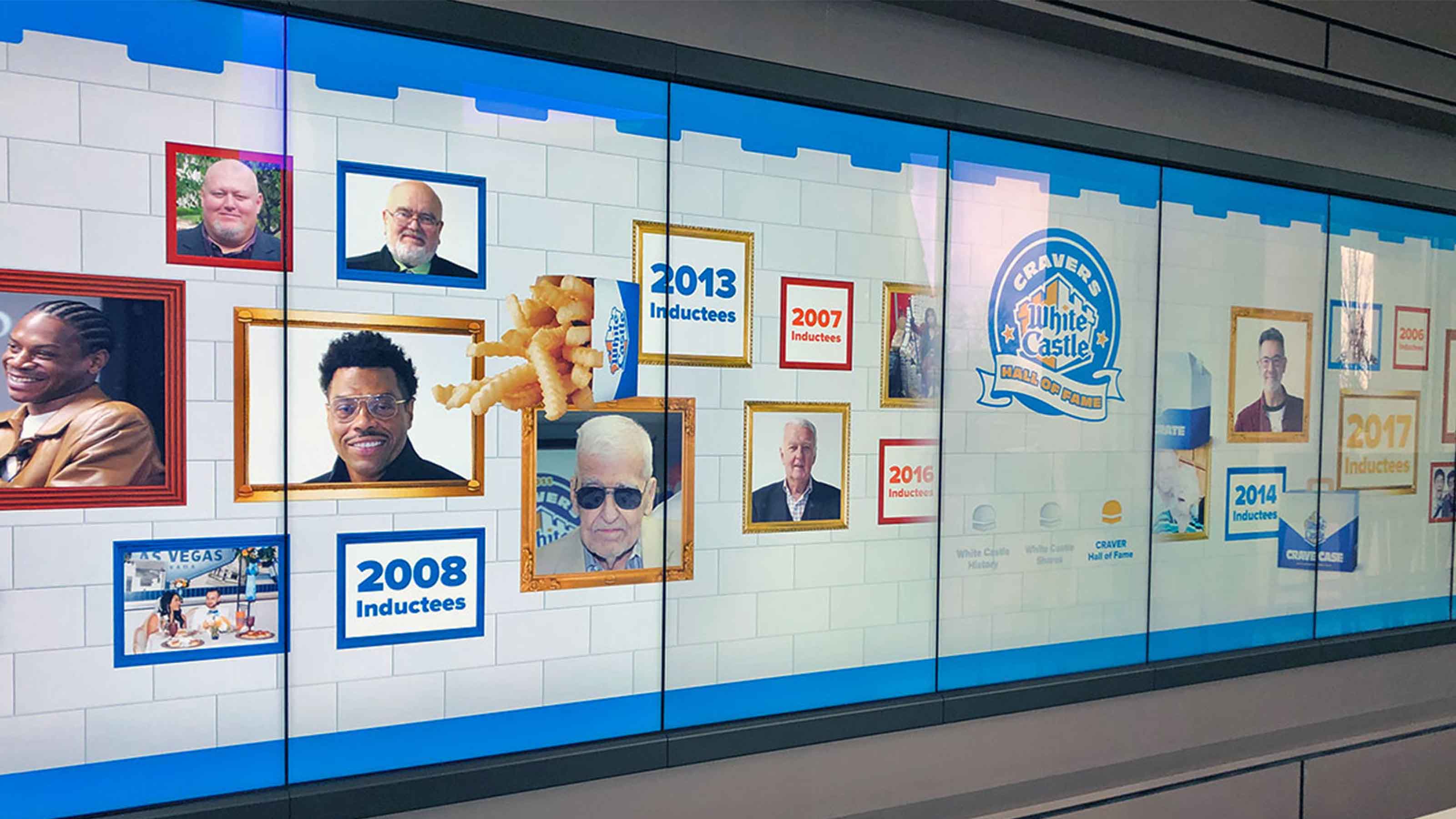It’s not just a hamburger, it’s an experience. At least at White Castle’s new headquarters in Columbus, OH.
Its lobby features a multi-screen "Storywall" that operates in three interactive modes: History (exploring White Castle’s rich brand history), Craver Hall of Fame (to celebrate loyal fans of this iconic fast food brand), and White Castle Shares (detailing the company’s community and charitable efforts.) The White Castle HQ also features a projection-mapped carved wooden throne that guests can sit on for free photos, as well as a Founder’s Desk rotary phone that, when picked up, plays audio recordings from founder E.W. “Billy” Ingram.
Installed by Bluewater Technologies Group (Bluewater Tech), White Castle HQ is an example of the growing trend toward experiential content. Other such interactive AV installations can be found everywhere from Times Square to corporate offices to entertainment venues—basically anywhere people gather and can be reached by entertaining, engaging multimedia content.
The Key Word
Experiential content is defined by the root word "experience." The goal of this content is to create moments within environments in which people can participate. Experiential content goes beyond looking at a screen to actively interacting with it, downloading or sharing content, or connecting with other people in the same or other locations.
“Experiential content is a growing trend in the AV industry,” said David Wilkins, founder and CEO of Zenapptic.AI. “Everybody wants an experience now. It's not just enough to look at something on a screen. They need to feel connected to that or connected to other people in the environment.”


One target audience for experiential content is employees, who often see messaging at work every day. “It is both an extension of your brand and of your company,” said Scott Schoenberger, managing partner at Bluewater Tech. “As such, experiential content transforms the office into a platform for entertainment and sales enablement. It allows you to design spaces that encourage people to want to show up rather than being forced to show up.”
Defining Opportunities
Investing in experiential content and its supporting hardware is justified whenever a client’s AV goal shifts from passive viewing to making a direct connection with the people in front of the screens. “When it comes to what we’re trying to achieve at Zenapptic.AI, the most important word is engagement,” Wilkins told SCN. “It's not just about the dwell time, it’s about connecting with people in a real and meaningful way.”
Other factors affecting investment are the level of interaction and the client’s ultimate goal. If the desired outcome is for viewers to interact actively with the content—to connect to it, download it, share it, or connect with others in the space—experiential content is the right choice. But for the investment in experiential content to pay off, the content itself must align with the client’s ultimate goal for the space, whether that's to grab viewers’ attention, deliver an emotional story, or offer a direct reflection of the client’s core values.
This is why the first part of Bluewater Tech’s work with its experiential content clients is what Schoenberger called the "alignment phase." Typically, they ask questions to find out what the client is ultimately trying to achieve.
“Sometimes it's as simple as, ‘We just want this to be really cool art’. Other times it's about the storytelling, perhaps a little bit of ‘Here's what we're inspired by,’ the emotions they want to evoke in the viewer, and the message that they want to get across," he explained. “It's all case by case: When it comes to experiential content, there’s no ‘one-size-fits-all’ approach that works.”
Budget obviously drives a lot of the creative decisions. "If we're limited by budget or by space, it might be a series of monitors in some kind of artistic format that will ultimately drive what the content becomes and how we play it back," Schoenberger offered. "If there's more space and more budget we can be more creative by using LED panels in various shapes and locations, which gives us more room and options to work with.”
Practical Considerations
Given how varied experiential content installations can be in scale and complexity, summing up system requirements can only be done in a generalized sense. What can be said is that a typical experiential content installation is platform-centric, with the Experience Management System (EMS) software acting as the hub connecting all physical elements.
“Everybody wants an experience now. It's not just enough to look at something on a screen.”
David Wilkins, Zenapptic.AI
This includes all display screens, data/video/audio servers, amplifiers, routers, surround sound audio systems, loudspeakers, and lighting. Depending on the budget and project needs, the video can be shown using standard monitors in artistic mosaic layouts, LED displays for custom, scalable shapes, and/or projection in controlled-light environments.
Not surprisingly, AI is playing an ever-larger role in experiential content installations. At the front end, AI can be used to create graphics and video content as needed. At the back end, AI can effectively manage the interactive experience by using live input from viewers to shape the playout choices—and, through interactive feedback, tweak it over time in response to detected viewer preferences.
“Using AI, we can orchestrate things across all kinds of different screens, spaces, and locations and do really, really interesting things,” said Wilkins. “Take hospitality: If you're using your big ballroom for a wedding one weekend, you can type in some prompts and upload some images, allowing the entire space to come to life with content related to that wedding. The next day, when you're doing a corporate event, you can upload your PowerPoints, photos, and videos, and the whole space completely transforms.”
Doing Experiential Content Right
The time-worn adage, "garbage in, garbage out,” applies to experiential content as much as it applies to inventory data management. If you want to create experiential content that wows viewers while satisfying clients, you’ve got to plan, create, and play it out properly.
The first step is understanding the client’s goal. This requires the alignment phase that Wilkins outlined. Ask questions to the client, lots of them. Then, define what the space is all about and what kind of engagement you are trying to build before deciding on the specific hardware or technical approach. Next, choose the right equipment and video resolution for the job.
"I'm a big fan of Pixel Perfect content," said Schoenberger. “I realize that budgets can be tight and that we want to reuse existing video content whenever we can. But I think my biggest piece of advice is to always be aware of the pixel map and your resolutions that you're working with. Content that’s been stripped from YouTube can look blurry and skewed on a large display. And after all, it's not difficult to take existing assets and bring them up to the right resolution and size, so that they look good in your experiential content."
The last step in creating great experiential content is “to make sure you're having fun with it,” he concluded. “This includes your display shape and layout. A lot of people stick to rectangles because it’s easy, but that's not always fun, playful, or exciting. Be willing to push yourself out of your comfort zone and try new things!”

